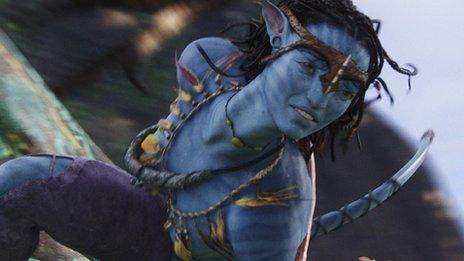Has 3D film-making had its day?
- Published

It's three years since audiences around the world swarmed into cinemas to see James Cameron's Avatar. It rapidly became the biggest grossing film of all time, in part because of its ground-breaking digital 3D technology.
But, in retrospect, Avatar now seems the high-point of 3D movie-making, with little since 2009 to challenge its achievement. Three years on, has the appeal of 3D gone flat?
Nic Knowland has been a respected director of photography in Britain for 30 years. He's seen cinema trends and fads come and go, but never one for which he's had so little enthusiasm as 3D.
"From the cinematographer's perspective it may offer production value and scale to certain kinds of film. But for many movies it offers only distraction and some fairly uncomfortable viewing experiences for the audience. I haven't yet encountered a director of photography who's genuinely enthusiastic about it."
'No resemblance'
Nic Knowland's opinion of 3D is backed by another British cinematographer Oliver Stapleton, who has shot Hollywood movies such as The Cider House Rules and The Proposal.
"3D is antithetical to storytelling, where immersion in character is the goal. It constantly reminds you you're watching a screen - and it completely prevents emotional involvement. Natural human vision bears no resemblance to 3D in the cinema."
"2D doesn't reveal the smoke and mirrors of filmmaking in the same way. Of course that's partly because we're used to it, but also - it's not trying to mimic our vision.
"My goal as a cinematographer is to make the stitches in the cloth invisible. 3D says 'Look at me, I'm a picture!', 2-D simply says 'Once upon a time...'"
Both Knowland and Stapleton accept that 3D technology can contribute to animated films such as Avatar (which Nic Knowland says is probably the best use of 3D he knows). But neither has been persuaded by anything since James Cameron's huge hit that the medium can reliably serve the needs of serious drama.
A current release that might give doubters pause for thought is Ang Lee's film, Life of Pi. Critics have praised the director's imaginative and sure-footed use of 3D, as the young hero drifts on the ocean slowly taming an impressively realised and very scary tiger.
Ang Lee is adamant that used intelligently 3D has now earned its place in drama: "Maybe because the 3D experience is still new, it does confuse some audiences. But a good director can use that confusion as a convincing-tool, to make audiences believe in what's on screen."
'Natural level'
But did Ang Lee have initial doubts about the technology? "Oh all the time. We have a long relationship with how 2D looks and with the good storytelling it's given us. We've grown up enjoying its solidity - although filmmakers compensate the eye with the illusion of depth and with shadows.
"3D is more elusive - we trust and mistrust it at the same time. I think it reminds us of the first movies we saw in our childhoods."
"When a new medium comes along, people don't take it seriously because we don't associate it with good filmmaking. It gets used for cartoons, action movies and cheap horror. But the medium itself is neutral - it's how you use it. And we're still establishing its language."
Torsten Hoffmann is a German who recently moved his 3DContent Blog website to Australia. From there he's following what he says is now the real growth in the 3D market: Asia, and especially China and South Korea.
"China alone has around 10,000 screens equipped for 3D - that's almost a quarter of the worldwide total. And where Chinese audiences have been offered a choice between seeing the same film in 3D or flat in 2D, they've overwhelmingly chosen the former. And it's not just in the cinema - CCTV (China's main state broadcaster) is investing heavily as well."
Robert Mitchell, of Variety magazine in London, says since 2009 3D has found its natural level with audiences in Europe and America.
"Most people have become pretty sophisticated about what they genuinely need to see in digital 3D, as opposed to films where they suspect it won't improve the experience - or may even be annoying. After the high-point of Avatar, people got smart about lesser films where it probably wouldn't be worth paying the 3D surcharge.
"And the studios aren't stupid: they soon realised that almost no one goes to see a movie just because it's in 3D. When a film is well thought-out from the beginning for 3D, you can see that. Good recent examples are the animated film Madagascar 3: Europe's Most Wanted or the most recent Transformers movie. On the other hand I think the final Harry Potter film didn't benefit from being in 3D at all."
"Directors such as Wim Wenders, Werner Herzog, Martin Scorsese and Ang Lee have shown that 3D can be used interestingly.
"3D isn't all junk - and those who say the technology has proved a flop are exaggerating. But so far Christopher Nolan isn't a fan and we'll never see Quentin Tarantino in 3D - he doesn't even like digital."
"The next big test may be Baz Luhrman's version of The Great Gatsby, due for release in May and starring Leonardo DiCaprio. It doesn't seem like a natural fit for 3D, but Luhrmann's a very stylistic director and he may make it work."
"But it's true that the sense there was three years ago - that the studios wanted 3D to be the automatic choice for all big movies - has passed. The filmmakers fought back and won."
- Published11 December 2012
- Published21 November 2012
- Published24 October 2012
- Published9 August 2012
- Published27 September 2011